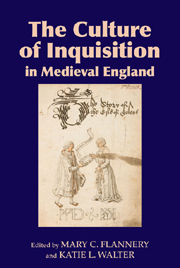Book contents
- Frontmatter
- Contents
- Illustrations
- List of Contributors
- Acknowledgements
- Abbreviations
- Introduction: Imagining Inquisition
- 1 Inquisition, Public Fame and Confession: General Rules and English Practice
- 2 The Imperatives of Denunciatio: Disclosing Others' Sins to Disciplinary Authorities
- 3 English Provincial Constitutions and Inquisition into Lollardy
- 4 The Contest over the Public Imagination of Inquisition, 1380–1430
- 5 ‘Vttirli Onknowe’? Modes of Inquiry and the Dynamics of Interiority in Vernacular Literature
- 6 From Defacement to Restoration: Inquisition, Confession and Thomas Usk's Appeal and Testament of Love
- 7 Confession, Inquisition and Exemplarity in The Erle of Tolous and Other Middle English Romances
- 8 Heresy Inquisition and Authorship, 1400–1560
- 9 Imitating Inquisition: Dialectical Bias in Protestant Prison Writings
- 10 Response Essay: Chaucer's Inquisition
- Bibliography
- Index
8 - Heresy Inquisition and Authorship, 1400–1560
Published online by Cambridge University Press: 05 April 2013
- Frontmatter
- Contents
- Illustrations
- List of Contributors
- Acknowledgements
- Abbreviations
- Introduction: Imagining Inquisition
- 1 Inquisition, Public Fame and Confession: General Rules and English Practice
- 2 The Imperatives of Denunciatio: Disclosing Others' Sins to Disciplinary Authorities
- 3 English Provincial Constitutions and Inquisition into Lollardy
- 4 The Contest over the Public Imagination of Inquisition, 1380–1430
- 5 ‘Vttirli Onknowe’? Modes of Inquiry and the Dynamics of Interiority in Vernacular Literature
- 6 From Defacement to Restoration: Inquisition, Confession and Thomas Usk's Appeal and Testament of Love
- 7 Confession, Inquisition and Exemplarity in The Erle of Tolous and Other Middle English Romances
- 8 Heresy Inquisition and Authorship, 1400–1560
- 9 Imitating Inquisition: Dialectical Bias in Protestant Prison Writings
- 10 Response Essay: Chaucer's Inquisition
- Bibliography
- Index
Summary
Any reader of heresy trials must decide how seriously to take the official version of events.
An extreme power differential existed between members of the ecclesiastical court, who both recorded the trial and rendered judgement, and the accused, who stood trial before them. At no point was this imbalance more apparent than at the end of a trial when, if not acquitted or convicted for relapse, the defendant formally recanted previous beliefs in an abjuration. This document that was also an oath depicted the defendant's change in belief from previously held heresies to newly adopted faith as determined by the church, and enforced by the ecclesiastical court. What is more, the abjuration required a confession of orthodox faith not unlike the creed, in which the defendant pronounced, in the first person, his or her agreement with orthodox belief. How can someone faced with the prospect of execution be sincerely convinced of his or her error, as the language of abjuration attests, and not be acting in the interest of self-preservation? The fact that the court required abjurations to be written in English, drafted in the first-person voice and signed by the accused merely reinforced the problem of their authenticity.
- Type
- Chapter
- Information
- The Culture of Inquisition in Medieval England , pp. 130 - 145Publisher: Boydell & BrewerPrint publication year: 2013



